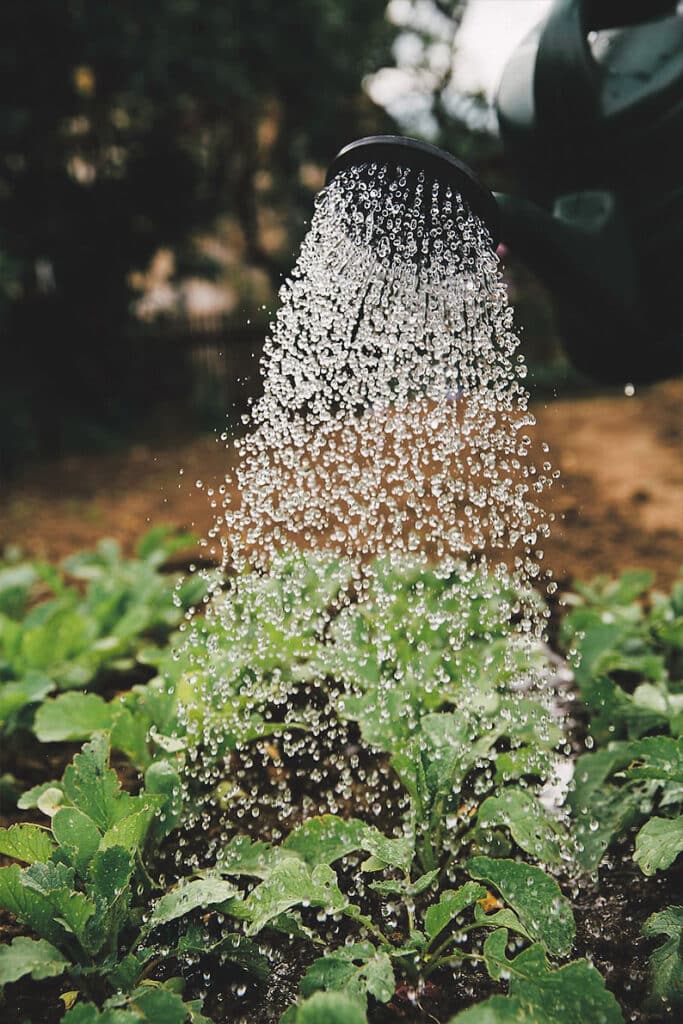At this time of year, it is essential to keep most plants watered. Here at Deelish Garden Centre, we are spending a couple of hours each day watering our plants from our well water. There is no simple rule of thumb for watering as each plant has different needs – for example, a container plant in hot sunny weather may need watering twice daily, whereas a mature shrub might only need a drink in extreme drought. Be aware that potted plants freshly planted will need regular watering until they have established a good root system. If possible, water in the mornings, as when the sun comes up the plants will start to use the water. The foliage and soil surface is also likely to stay drier for longer than it would after the evening watering, discouraging slugs, snails and mildew diseases.

The best way to tell if your plants need water is to stick your finger about an inch into the soil, and if it feels dry, break out the hose or watering can. If you do detect dampness, check the soil in a day or two. There’s a reason pots have drainage holes — too much water will literally drown your plants. That’s because roots do need oxygen or they will rot and die. Even with good drainage, keeping the soil constantly wet can make it hard for air to reach the roots. There are a few ways to tell if you are overwatering your plants before it’s too late to save them. No new growth and yellowing leaves that are dropping off can be signs of overwatering. You may also notice wilting, which can be confusing because that is also a sign of too little water. The trick is to check the soil when you notice these problems: If it feels wet, you probably should go easier on the water. If the soil is dry, you may need to give your plants more water.
For seedlings, delicate plants and cuttings, I try to use warm rainwater, as many types of disease and wilts are caused by using dirty or contaminated water. Simply fill a watering can and leave in a warm spot before watering. If you are having issues with ‘damping off’ on small seedlings, boil your water first and leave to cool before watering seed trays. A strong brew of chamomile or cinnamon tea is also an effective remedy for ‘damping off’, simply water and/or mist your seedlings with this tea. Only use fresh clean tap or well water on salads and other crops eaten raw- for obvious reasons.
I prefer to use a watering can fitted with a fine rose at the end, as it is gentle on young plants and unlikely to disturb roots close to the surface. If using a hose be sure to fit an adjustable nozzle and be careful not to blast the soil around the base of plants as this can expose roots to the surface and cause damage to plants. Where possible try to water the soil and not the leaves, as this can lead to sun scorch (resulting in burn marks on the leaf) or fungal problems.
We talk a lot about when and how to water a plant, but water quality over time can be just as important. Whether it’s talking to your plants or adding nutrient-rich fertiliser, there are multitudes of ways people help their plants grow. A great way to ensure healthy plants is to use the right water to nourish them. Water quality can impact your plants in a variety of ways, and this is even more important when it comes to growing fruits and vegetables. The things you grow in your vegetable garden presumably make it into your body. This not only means that clean water impacts your plants’ health, but it can have an effect on your own health as well.
What do I mean by water ‘quality’? Water quality can refer to chemical, microbial or physical properties. If you have a private well or spring water, you need to be concerned about all three of these, but for gardeners using mains water to grow plants, it is the chemical issues that are a major concern.
What chemicals in the mains water can affect your plants?
Chlorine, fluoride and pH can all affect your garden plants and vegetables.
Chlorine: It evaporates within a few days if you allow the water to stand at room temperature in a wide container. Most plants are not too sensitive to chlorine. Chlorine serves as an effective means of removing pathogens from drinking water, but many gardeners fear that it will also eliminate many of the beneficial microbes in the soil. However, there are two key factors that do not make chlorine a major threat to microorganism populations:
1. Microorganisms reproduce at such a rapid rate that – even if chlorine kills some of the microbes–their populations can easily rebound in a short amount of time if you have healthy soil quality.
2. When chlorine enters the ground, it binds to the surface soil particles and does not travel to the beneficial microorganism colonies that live in the lower soil layers.
While the average chlorine concentration in tap water has not been shown to do lasting damage to plants, chlorine toxicity is still possible. A tell-tale sign that your fruits and veggies may be suffering too much chlorine is if their leaves appear burnt.
Fluoride: Some plants are sensitive to fluoride, especially those with long narrow foliage such as Willows, spider plant, Easter lily, peace lily and parlour palm. Over time these plants will show brown tips from excess fluoride.
Flushing the soil with rainwater can reduce the build-up of fluoride. Fluoride can also be removed from water with special treatment, such as reverse osmosis, and water distilling systems. There are more and more options becoming available on the market each year and prices are very reasonable.
pH: Plants grow best with a soil pH of 5.0-6.0, so higher pH in mains water, especially for acid loving plants such as Citrus, Rhododendrons and Camellias can be an issue. High pH limits the availability of some nutrients such as iron; plants with iron deficiency are chlorotic and have leaves with green veins and yellow in between. High pH water usually does not affect plants grown in the ground outdoors as there is such a large volume of soil. But in a container, over time water pH can change the soil pH because it’s a small volume of soil.
To reduce high pH in water, most water-soluble fertilisers make the water acidic, or you can simply add a few drops of acid such as vinegar or lemon juice to the water (1/4 tsp to four litres). Over-fertilisation can lead to brown leaf tips as well, so using half the recommended strength is a good idea. Be sure never to feed a plant on dry soil, simply water without adding liquid feed first and add the liquid feed once the soil is moist.
If you are concerned about the quality of your own water, there are laboratories that test water for its suitability to grow plants. These tests are different from those used to determine the suitability of water for household use and human consumption. When water is tested for plant suitability the mineral nutrient content is analysed, as well as the pH, which affects the availability of nutrients for the roots to take up.
Be sure to see Peter Tadd’s piece (opposite page) on GRANDER™ Water-Revitalisation and feel free to come to Deelish Garden Centre on August 15, from 11am to 2pm for a talk and demonstration of this completely natural process, designed to improve water quality.
All the best with the growing season ahead and remember, gardening doesn’t have to cost the earth!



